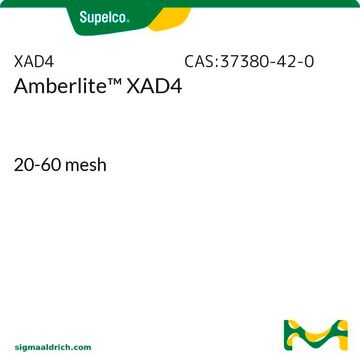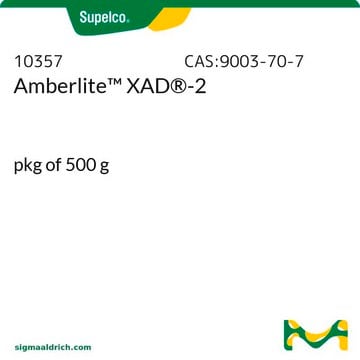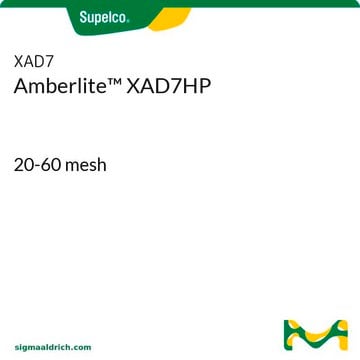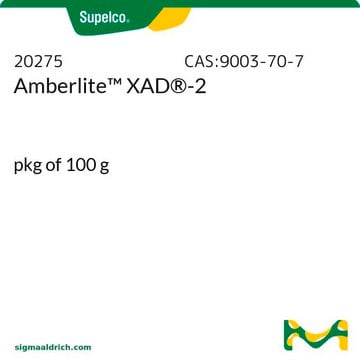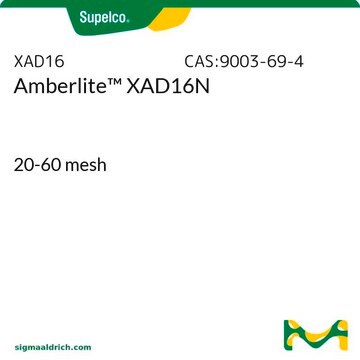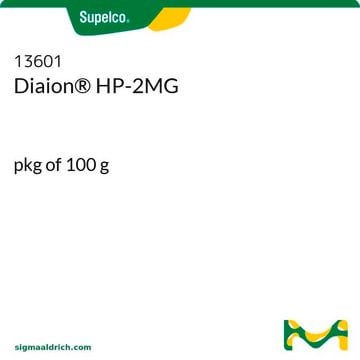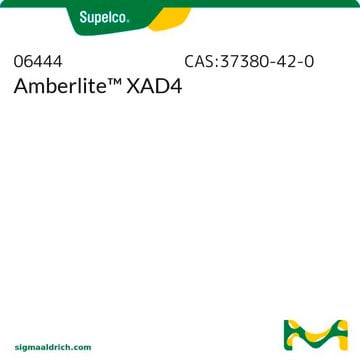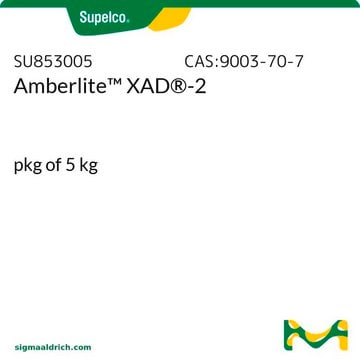Recommended Products
form
solid
autoignition temp.
800 °F
packaging
pkg of 100 g
technique(s)
HPLC: suitable
LPLC: suitable
surface area
750 m2/g
matrix
styrene-divinylbenzene
matrix active group
polymer
particle size
20-60 mesh
pore size
~0.98 mL/g pore volume
100 Å mean pore size
density
1.02 g/mL (true wet)(lit.)
1.08 g/mL (skeletal)(lit.)
separation technique
reversed phase
Looking for similar products? Visit Product Comparison Guide
General description
Amberlite XAD4 is a nonpolar absorbent used for stripping and concentration of organic compounds. Bacillus subtilis immobilized on Amberlite XAD-4 has been investigated as new biosorbent in trace metal determination.
Nonionic macroreticular resin that adsorbs and releases ionic species through hydrophobic and polar interactions; usually used under isocratic conditions.
Application
- Amberlite™ XAD4 was used in rapid fractionation technique.
- Amberlite XAD4 was used as sorbent for HPLC analysis.
Polyaromatic adsorbent for small hydrophobic compounds, surfactants, pharmaceutical manufacturing, phenols, chlorinated organics, pesticide removal and recovery, and organic removal from aqueous food streams.
Other Notes
Two particle sizes are available:
Mesh 20-60 are Cat. Nos. 20276, 10358, XAD4
Mesh 20-50 is Cat. No. 06444
Mesh 20-60 are Cat. Nos. 20276, 10358, XAD4
Mesh 20-50 is Cat. No. 06444
Legal Information
Amberlite is a trademark of DuPont de Nemours, Inc.
Storage Class Code
11 - Combustible Solids
WGK
WGK 3
Flash Point(F)
Not applicable
Flash Point(C)
Not applicable
Personal Protective Equipment
dust mask type N95 (US), Eyeshields, Gloves
Choose from one of the most recent versions:
Already Own This Product?
Find documentation for the products that you have recently purchased in the Document Library.
Customers Also Viewed
Siva Sarathy et al.
Water research, 44(14), 4087-4096 (2010-06-18)
The advanced oxidation process utilizing ultraviolet and hydrogen peroxide (UV/H(2)O(2)) is currently applied in commercial drinking water applications for the removal of various organic pollutants. Natural organic matter (NOM) present in the source water can also be oxidized and undergo
Mehmet Dogru et al.
Journal of hazardous materials, 149(1), 166-173 (2007-05-01)
The present work proposes the use of Bacillus subtilis immobilized on Amberlite XAD-4 as new biosorbent in trace metal determination. The procedure is based on the biosorption of Cu and Cd ions on a column of Amberlite XAD-4 resin loaded
A S Ghatbandhe et al.
Journal of environmental science & engineering, 50(2), 163-168 (2009-03-20)
Adsorption equilibrium, kinetics and thermodynamics of 2,4-dichlorophenol (2,4-DCP), one of the most commonly used chlorophenol, onto bituminous coal based Filtrasorb-400 grade granular activated carbon, were studied in aqueous solution in a batch system with respect to temperature. Uptake capacity of
Imam Bakhsh Solangi et al.
Journal of hazardous materials, 176(1-3), 186-192 (2009-12-03)
The article describes a convenient method for the modification of Amberlite XAD-4 resin by introducing thio-urea binding sites onto the aromatic rings. The modified (ATU) resin has been employed for the quantitative sorption of fluoride ions in batch as well
Imdadullah Qureshi et al.
Journal of hazardous materials, 164(2-3), 675-682 (2008-10-03)
The article describes a convenient synthesis and Cr(VI) extraction efficiency of a novel p-tert-butylcalix[8]areneoctamide impregnated Amberlite (XAD-4) resin. Using p-tert-butylcalix[8]arene macrocyclic building block, two strategies have been developed; i.e., derivatization of p-tert-butylcalix[8]arene framework with sophisticated ionophoric groups having efficiency to
Our team of scientists has experience in all areas of research including Life Science, Material Science, Chemical Synthesis, Chromatography, Analytical and many others.
Contact Technical Service